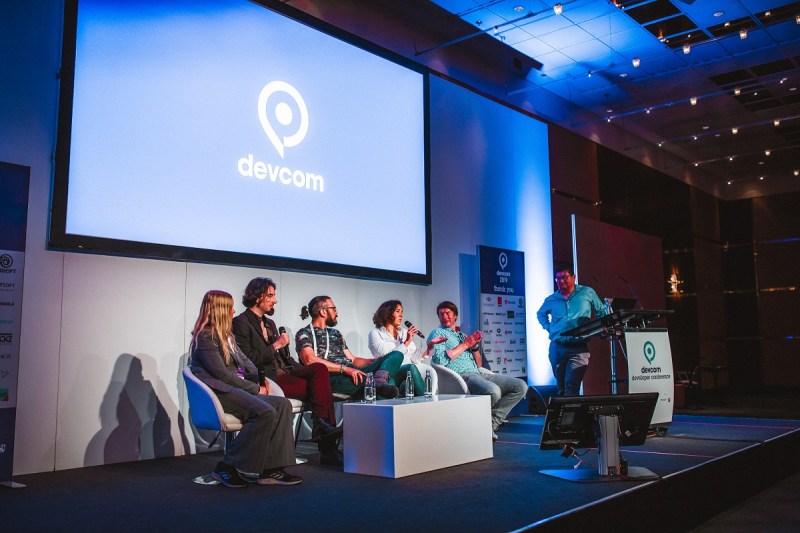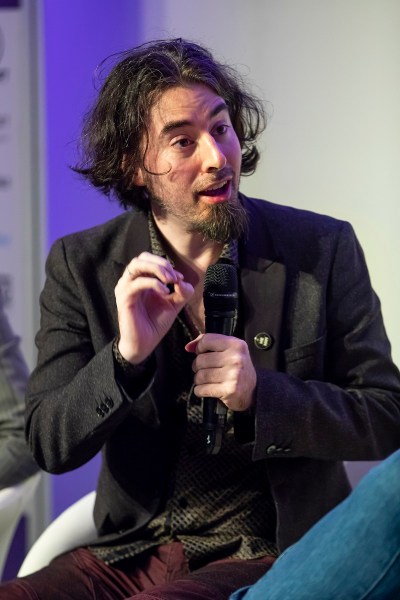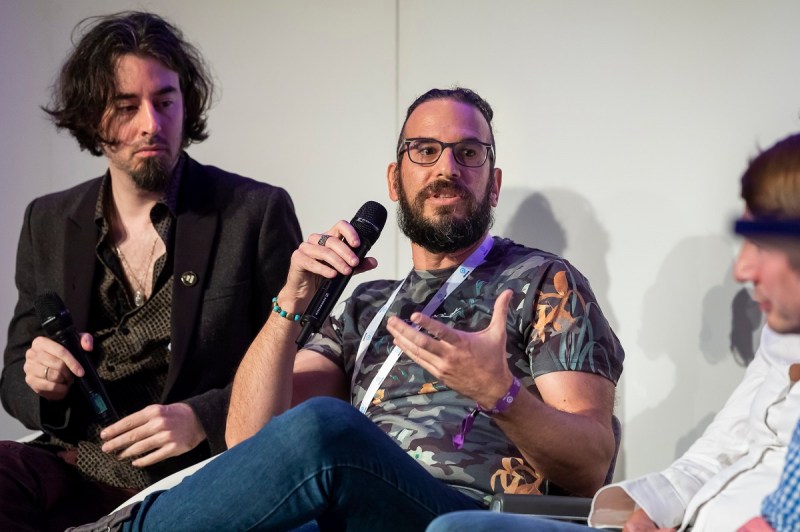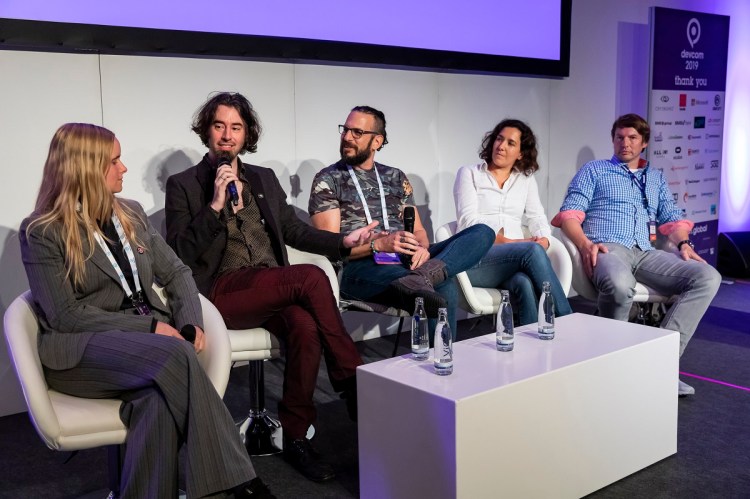It has been a tense and horrifying year of mass shootings in the U.S., with the blame falling on many issues, including President Donald Trump and the guns. Trump himself tried to shift blame to violent video games, which he said led to a “glorification of violence” in mass culture. Although no research supports a connection between violent games and real-world violence, the game industry is on the defensive again. We tackled that subject at Devcom, the recent game developer conference in Cologne, Germany.
The panel was entitled, “The uncomfortable and familiar topic of video game violence.” Most of the coverage of this issue has been pretty thin, but we tried to probe deeper into the issues related to game violence with a diverse panel of game developers who have made different choices about how to depict violence and its consequences.
Our panelists included Timo Ullman, managing director of Berlin’s Yager Development, creator of Dreadnought and Spec Ops: The Line. The latter was notable as a shooter game that brought up the issues of excessive force and civilian casualties in war. Antonia Koop, CEO of Kite Rider Strategic Adventures, also spoke. She is a former war correspondent and now makes immersive training simulations for businesses.
Another panelist was Tsahi Liberman, head of business development and marketing at Simpool. He is also a former soldier in the Israeli army and a designer of games for peace. His team won the UN Prize two years ago for Games for Peace, which connects children around the world in conflict zones and changes their attitudes toward other ethnicities through games.
June 5th: The AI Audit in NYC
Join us next week in NYC to engage with top executive leaders, delving into strategies for auditing AI models to ensure fairness, optimal performance, and ethical compliance across diverse organizations. Secure your attendance for this exclusive invite-only event.
Other panelists included James Portnow, who worked on the Call of Duty series in the past. His credits include FarmVille and League of Legends, as well as the host of a show called Extra Credits. Catharina Bøhler, CEO of Sarepta Studio, which created the emotional impactful mobile game My Child Lebensborn, which was about the children of Norwegian women and German soldiers in the wake of World War II.
Here’s an edited transcript of our panel.

Above: Left to right: Catharina Bøhler, James Portnow, Tsahi Liberman, Antonia Koop, Timo Ullmann, and Dean Takahashi.
GamesBeat: This is a very interesting panel. We did try to invite some people who currently work on Call of Duty, but we couldn’t get them to come for various reasons. I think everyone knows that President Trump blamed the glorification of violence in video games as one reason for mass shootings in the U.S. I think a lot of people in the industry, and a lot of gamers, can see some BS in that, and a distraction from a lot of real issues out there. But the game industry itself did not seem to go on the attack, especially the Entertainment Software Association, which was relatively quiet. I wonder if anybody has an opening thought about this. Was the ESA’s lack of response the wrong thing to do, or the right one?
Portnow: Video games have been under attack since before I got into the industry, just like comic books and rap music. Any new art form is going to be under attack around these kinds of things, so we do have to defend it. But just because we have to defend it doesn’t mean that here, among ourselves, we can’t also admit that we have to do things better. If we’re going to say that games are an art form, that they do impact people, we can’t just say that’s the case when it’s positive for us, when it makes us look good. We have to say that there are better ways to impact people and think about that.
I think the ESA should have once again gone on record and said, “Video games don’t make you violent. We’ve proven that plenty of times.” But we should also have a conversation within the industry about what we can do better to make sure that games don’t normalize violence, don’t create communities of violence, don’t allow for spaces where we harbor people who have violent tendencies.

Above: James Portnow, writer of Extra Credits.
GamesBeat: You hit the nail on the head as far as what we want to do where, which is talk about how we can do things better.
Antonia Koop: For me, violence is an interesting topic in terms of depiction in games, because in our work we do use the ability of games to be incredibly realistic — to simulate situations, simulate events unfolding, for training purposes. We replicate reality. We replicate the impact that real experiences have in a safe environment using games technology. That raises the question of, if we can do that — if we can use game technology to create a real learning impact — does the game experience we’re creating for fun also have real impact, and what does that impact look like?
At the same time, as you said, there’s no simple connection. There’s no way that we just play a violent game and then go out and shoot someone, because otherwise most people in this room would have gunned people down by now. So what is that link? What is that impact? What affects how games affect us? That’s the interesting question from the developer point of view.
Bøhler: Can you make sure that there are certain things you do in a game to make people understand that this does have an impact? Just put in something that makes people stop and think a little bit more. A lot of shooter games have done that now, which is great, but we can always do a bit more.
Timo Ullman: The question about impact, how is that going to be driven? Who is going to judge what kind of impact is made? In Spec Ops, it’s a very theoretical approach, because none of us has ever been to war and seen what it does to people. We wanted to take what we’ve seen in other media and get that in a game, to explore the way the road to hell is paved with good intentions. What kind of decisions would you come across, and what would that mean to you? How would it affect you?
At the same time, I remember back then the discussions we had about how we were going to portray the violence in the story. Are we going super over the top? Are we going very subtle? Do we leave a lot of things to the fantasy of the individual player? Because players are such a diverse group, there’s no easy answer to that.
Coming back to the question of our responsibility, in the first place I believe in the freedom of the creator. Then it gets interesting, though. What does the content we create mean to people? How do they perceive this content? That’s a very wide topic, and one that’s very interesting to explore.
Liberman: I’m also in support of the freedom of the creator. Violence itself — I’ve played violent games most of my life, but I’ve been a very peaceful person on the other side of the map. I’ve been in war situations and seen the face of violence and war. As we said before, you’re a changed person when you’re in a violent situation, when you’ve seen that.
As artists, and also in my opinion as educators and narrative creators, it’s our job to show the consequences of violence. It’s not just a bunch of pixels we slay, and then it drops to the floor. It has no name and has no meaning. If I can chop down through hordes of zombies, soldiers, women, children — there’s something there we need to pause on, at specific moments in our narratives and our games. We need to show, “This is what you did. It has consequences.” For good and for bad, but it’s part of our story. If you want to do that you need to raise empathy for the other.
Your enemies are not just — it’s a big word, to say “enemies.” They have families. They’re people like you. Maybe some of them are game developers. In the second Lebanon war, I was a soldier in Lebanon, and I was already a game developer. On the other side, there were people who were game developers like me, from Syria and Lebanon. It’s our job to show that violence isn’t just shooting, mass killing people. It’s part of the story. It’s not only our job, but also those of teachers, to educate from an early age about the consequences of violence and the decision-making there.

Above: Tsahi Liberman speak at Devcom panel on game violence.
GamesBeat: It’s interesting that a few of you have chosen not to play the game, or you’re choosing to make games that don’t have violence in them — games that are about alternatives to violence, that address serious topics but don’t have that conflict them. That’s one interesting choice. The other is, if you’re going to make a violent game, how do you do it in a way that’s respectful and not exploitative?
Liberman: A game like This War of Mine did that perfectly. First of all, they worked with psychologists. They interviewed people who experienced war, and they tried to portray a very hard situation. I managed to play the game only on my fifth session. For me it was a PTSD situation, seeing one to one what I had seen in war. It was very hard.
But what was amazing for me was that every character I had in my team, in the building that was under siege, had a name. They had a history. They had data. They weren’t just a blank bunch of pixels. If Marina was dead because of decisions I made, that’s part of war — taking very hard decisions, and sometimes seeing them have an immediate effect. People get sick. They die. You make difficult decisions in war, and you need to decide whether you might act against an innocent sometimes. It’s hard to live with that. That’s something I think that game did very well.
GamesBeat: You can be very aggressive in that game. You can choose to steal somebody else’s food.
Liberman: You can choose to steal, but you know what was really effective for me? The expansion, The Little Ones — suddenly I was playing a whole different way. The violence took on a new face because I had a small child I had to take care of. He was asking, “Hey, why are you doing this to innocent people? Why does this man have to die?” I didn’t just need to survive, but my child sees this situation in a specific way. I’m also in the role of an educator and father — not just helping him survive, but protecting him from becoming too traumatized.
Koop: As much as I’m totally with you there on so many levels — I loved that game as well. But driving the entire discussion about violence in video games into a corner where we’re only making peaceful games, or where we’re presenting violence in all its depressing detail, would leave us cornered in a way. An interesting question for me is, how can we use other kinds of media, which don’t have such a depth of storytelling, and still ensure that they don’t drive a particular perception of violence, or a glorified perception?
A critical question for me when dealing with violence, with the imagery of violence — I derive this from my own experience. I used to be a war correspondent, to provide some more background. There are a lot of tools for looking at the framing of conflict parties, for example. Who is it that we’re fighting against? Who is the perceived enemy? One angle that you talked about earlier is, do we have enemies — is there a firm line drawn between good and evil? Is it easy to justify attacking someone else? On a simpler level, how does this other person look?

